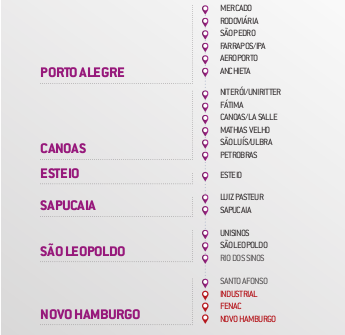The Porto Alegre Metro is an underground metro system that provides service to the Brazilian city of Porto Alegre. Currently, the system has one operative line and an extension in the airport, crossing through 22 stations on a north-south route.
This metro is also known as Trensurb, the name of the operating company that runs it. It is important to note that because the metro is relatively new, being opened in 1985, the system length its rather short, at only 43.4 km. The inauguration of the metro was held in the year 1985, and construction took 5 years. The system has had two important expansions since then, and several more are under planning. The basic tariff is R$1.70 (Brazilian real), about $0.53 USD, and the trains run from 5:00 a.m. to 11:25 p.m.
Metros in Brazil: Porto Alegre
The city
Porto Alegre is the capital of the state of Rio Grande do Sul, located in the Federal Republic of Brazil. Like the rest of the country, it was heavily influenced by Portuguese and Italian immigration in the 19th and 20th centuries, while it also has some German influences from that era.
Porto Alegre is one of the greenest cities in Brazil, and it also boasts one of the highest rates of education in the country. It has a total surface of 496.83 sq. kilometers.
The city has been deemed by the United Nations as the metropolis with the highest quality of life in Brazil. There are about 1.5 million people living within its borders, and about 4.4 million inhabitants in its metropolitan area. It is also one of the most expensive cities in the country, as the cost of living is quite high.
Porto Alegre has a rich cultural heritage, present in its many museums and cultural centers. There are plenty of such spaces exhibiting artistic performances. The city also has an important and lively sport scene, as it was chosen to be one of the venues that housed the 2014 FIFA World Cup.
The Metro
The Metro is one of the main transport systems in Porto Alegre. Its main purpose is to connect the central part of the city with its many suburbs, especially the ones to the north. The metro is complemented and supported by the bus network that covers the rest of city.
Currently, there is only one operative line, although there is a connection to the airport. The system extends for about 43.4 km, and provides service to 22 stations.
The rolling stock is comprised of different models of trains. The original model 100 trains were made by a Japanese consortium led by Nippon Sharyo, Hitachi and Kawasaki Heavy Industries. New trains were built and added to the system in 2014: the TUE Alstom 9000 made by Alstom. The latest addition is specific to the airport connection, and were made by A-X00, a Brazilian company.
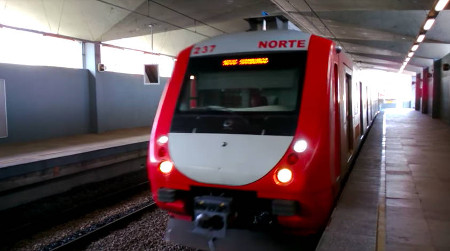
About 228,000 people use the metro every day. The operator of the system is Trens Urbanos de Porto Alegre S.A., also known as Trensurb, a public entity that is dependent on the federal government.
- Known as: Metro or trensurb
- System length: 43.4 km
- Track gauge: 1600 mm
- Number of lines: 1
- Number of stations: 22
- Maximum operating speed: 90 km/h
- Website: www.trensurb.gov.br
- Operated by: Trens Urbanos de Porto Alegre S.A.
- Daily ridership: about 228,000 people
- Inaugurated: March 2nd, 1985
Brief history
Transportation needs in the city of Porto Alegre had always been solved by increasing land transport routes, such as roads and highways. However, as with any large city, this system became unsustainable and the need to build a massive public transport system arose. The metro system was designed for the connection of the central part of the city with its suburbs, in which a large part of the population lives. Thus, construction began in 1980, with the first stage aiming to connect Porto Alegre with the northern suburbs of Canoas, Esteio, Sapucaia do Sul, São Leopoldo and Novo Hamburgo, as the only link at the time was the BR-116 highway.
The system was officially inaugurated on March 2nd, 1985, with the metro operating between the stations of Mercado and Sapucaia. For many years, the system remained in that state. It was not until December of 1997 that the inauguration of the first extension was held. It grew the system up to Unisinos station. A couple years later, another extension was finished: an expansion to the center of the nearby town of São Leopoldo. This provided an additional 2.4 kilometers of length. Another great extension of the Porto Alegre Metro was completed in 2012, when the system reached the town of Novo Hamburgo, extending the subway line by 4.9 kilometers. The expansion through Novo Hamburgo would continue in 2013, when three more stations were inaugurated, and an additional 9.3 km of track were incorporated.
However, the biggest change that the metro has experienced is the opening of the connection to the Salgado Filho International Airport, which also took place in 2013, creating a branch of the existing subway line for the first time. A people-mover automated train system was installed.
Schedule and timetables
The Porto Alegre Metro operates from 5 in the morning until 11:25 in the evening. Between the stations of Novo Hamburgo and Mercado, a train starts operations at five in the morning every day of the week, while the last one arrives at 11:25 p.m.
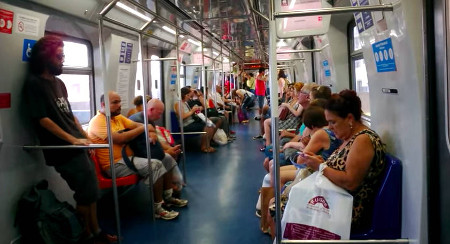 Trensurb Wagon
Trensurb Wagon
Regarding the frequency of the trains, it varies a lot during the day. From 5 a.m. to a short while before 6 a.m., the trains arrive every fifteen minutes. It then begins to increase. First, the frequency increases to about ten minutes and then quickly escalates to eight and then four minutes at its peak during the morning rush. This rhythm is maintained until 8:40 a.m., when a fixed frequency is established: one train every ten minutes. This is kept stable until 4:11 p.m., when the wait is reduced to eight minutes. From 5 p.m. to 6 p.m., it is further reduced to five minutes, while the wait is around three and a half minutes during the evening rush. After that, the frequency starts to descend as demand is lower, settling in to about eight minutes in the following hour and increasing to ten and then thirteen minutes as the closing hour approaches.
Weekends are somewhat different, as the frequency is reduced. On Saturdays, from 5 to 7:30 in the morning, the trains will pass every fifteen minutes. However, for most of the day the trains will run every ten minutes: from 7:30 in the morning to 7:30 in the evening. After that, the frequency will descend slightly to one train every eleven minutes, and then decreases further to one train every fifteen minutes during the following hours. The last trains of the day run with a frequency of seventeen minutes. Sundays are much more consistent, as trains run at a more uniform frequency of about fifteen minutes from the opening to the closing of the system.
In the case of the people mover that connects to the airport, there are slight variations. This small system also opens every day at 5 in the morning and closes at 11:25 at night. However, on weekdays, the frequency is set to ten minutes throughout the day. Saturdays will see the cars run every fifteen minutes from 5 to 7 in the morning, and then every ten minutes from 7 in the morning to 8:30 in the evening, finishing the day on a fifteen-minute frequency. On Sundays there is a single fifteen-minute wait between cars during the entire day.
Tariffs, tickets and cards
As with most large public transport systems, the user of the Porto Alegre metro has various ways to pay for the service. There are general entries and specific plans designed for daily users.
The first option are individual tickets, ideal for less frequent users of the system. A passenger may buy a single ticket that is only valid for the metro for R$1.70 (about $0.53 USD). This ticket is valid for a single ride and has no time limit, so users may ride for as long as they wish, considering they don’t leave the premises. There are also tickets that combine the metro and the bus network, and prices vary according to the city zone. If the ticket is bought for transport within the city of Porto Alegre, it will have a cost of R$5.18 (about $1.60 USD). If it is bought for use in Esteio, it will cost R$5.10 (about $1.58 USD). The price for a ticket for Canoas is R$5.40 (about $1.67 USD). Apart from this, tickets that handle two areas can also be acquired. Thus, a ticket that covers Porto Alegre and Esteio costs R$8.68 (about $2.69 USD), while a ticket for Esteio and Canoas is priced at R$8.95 (about $2.77 USD). Users will have to pay R$9.10 (about $2.82 USD) for the ticket that covers both Porto Alegre and Canoas.
On the other hand, a good option for people who use public transport regularly, is the Sim card. The word “sim”, in addition to meaning “yes” in Portuguese, represents the initials of the Integrated Metropolitan System (SIM, in Portuguese).
There are four different modalities with this card. The first one is called “SIM Passagem Antecipada”, and it is a preloaded card intended for general and frequent use. This is probably the main choice for most users of the metro and bus lines. There is another card called “SIM Vale-Transporte”. This is normally used by workers, as companies can preload the tickets into the cards. There is a special card called the “SIM Idoso”, a card that is only available for people who are 65 years of age or older. Finally, there is the “SIM Unitário”, a card that is only valid for the metro (it is not integrated with the bus network), intended for people who do not use the buses regularly.
The system also has compatibility with two other cards. They are the Integrated Transport card (known as TRI), which works for all buses and the Porto Alegre subway, and the TEU card, or metropolitan ticket, which is a rechargeable card with very similar conditions.
Lines and stations
The Porto Alegre Metro has only one operational line, composed of 22 stations that cover a total distance of 43.4 kilometers. This main route runs from north to south, connecting the city of Porto Alegre with all its suburbs located in the northern metropolitan area. Most of the length is covered superficially, at ground level.
On the southern end of the line, the terminal is Mercado station, located in the heart of the city of Porto Alegre, specifically on Avenida Júlio de Castilhos. This station has a bus terminal that is completely integrated with the metro system. This station allows for easy access to the city center, being close to the Mayor's office and other government buildings and federal institutions.
The next station on the route north is Rodoviária, which is one of the most important stations in the system. This is because it connects with the most important bus station in the city, from which they depart for the entire country.
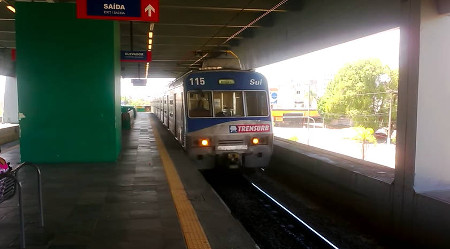
Further on is the São Pedro station, also located in Porto Alegre, near the coast of the Yacui River and on the Voluntários da Patria avenue, in the São Geraldo neighborhood.
After that, the trains arrive at Farrapos station, located on the A. J. Renner avenue, in the Navegantes district. This station is close to the UneSul terminal (a major bus operator), and has easy access to it.
Then we find Aeroporto station. It is located in terminal 1 of the international airport and connects with terminal 2 via the people-mover automated cars. The administrative offices of the metro system are in the vicinity of this station.
The next station is the last within Porto Alegre. Anchieta station, located on Avenida dos Estados. This station is located in the Anchieta neighborhood.
The Trensurb system then crosses the city limits of Porto Alegre and enters the city of Canoas, following the Guilherme Schell avenue along its route. The first station here is Niterói, which is the neighborhood of the same name, followed by Fátima station. Shortly after that, the trains reach Canoas station, located in the center of the city, next to public and religious institutions.
Another station in this city is Mathias Velho, which serves the neighborhood of the same name. It is then followed by São Luis station. The trains continue their path to the north until it reaches Petrobras station, located in the São José neighborhood.
With that, the metro finishes its route through the city of Canoas, and enters the borders of Esteio. The only station here is also called Esteio, and it is located on Rua Maurício Cardoso street, in the center of the city.
Next, we have Luiz Pasteur station, the first of two stations in the town of Sapucaia do Sul. It is located on Sapucaia avenue, in the Luiz Pasteur neighborhood. Further along the tracks is Sapucaia, in the central area of the town.
After this, the trains leave Sapucaia and reach Unisinos station, located next to the University of Vale do Rio dos Sinos and located on Mauá avenue in the Santa Tereza neighborhood of São Leopoldo. This is the followed with São Leopoldo station on João Corrêa avenue in the São José neighborhood. The other station in the area is Rio dos Sinos, located in the Santos Dumont district, on Mauá avenue.
Finally, the metro reaches the town of Novo Hamburgo. The first station here is Santo Alfonso, which is located on the Primeiro de Março avenue, in the Santo Alfonso neighborhood. This is followed by Industrial/Tintas Killing, located on the same avenue but a little further north, in the Industrial neighborhood. The next station is called Fenac, built on the Nações Unidas avenue in the Ideal neighborhood.
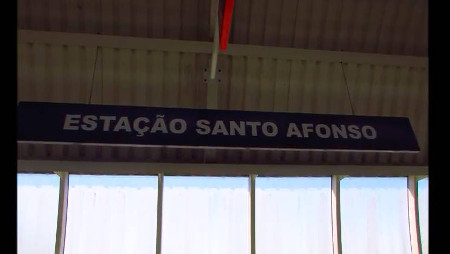
The last station on this side of the line (and the northern terminal) is Novo Hamburgo, also located on the Nações Unidas avenue, but in the Rio Branco district.
The special connection shuttle operates from Aeroporto station, located in Terminal 1 of Salgado Filho International Airport, and connects it with terminal 2 of the airport through small, fully automated cars.
Connections with other systems
The metro in Porto Alegre had been a necessity for a long time, but it only serves as a connection with the northern suburbs of the city for now. Thus, many areas of the city are not reachable my metro, and passengers must use other forms of public transport to reach their destination. Fortunately, there are many additional options a passenger can take. As is common on most large cities around the world, the transportation system by excellence are the buses, as they reach places trains cannot. The bus lines in Porto Alegre are operated by the Public Transport and Circulation Company (EPTC), dependent on the local government of Porto Alegre and unlike the metro, that depends on the federal government.
In total, there are 364 bus lines that run through every corner of Porto Alegre and its metropolitan area. In addition to buses, there are also 49 vans and minibus routes that serve a similar function. Many important bus stops are very close to the metro stations, making the connection and integration of both systems an easy task. There is also the possibility of taking a long-distance bus through Mercado and Rodoviária stations, as they connect to bus terminals.
Another very important means of transport in the city is the river. The port of Porto Alegre is the most important river port in Brazil, and it carries a large part of the cargo going into and out of the city. However, most of the ships that sail through the river transport cargo. Passenger traffic is almost non-existent.
Connections to the airport
Porto Alegre has an international flight terminal called Salgado Filho International Airport, managed by the German transport company Fraport since 2017. It is the airport with the most passenger traffic in the state of Rio Grande do Sul and the eighth in all of Brazil. This aerodrome is quite large, its surface is close to four million sq. meters. Originally, the airport had a single terminal, which is now known as Terminal 2 or Old Airport. As the limited capacity of the facilities started to become an issue, the airport was renovated. In 2001, a new modern airport terminal was inaugurated. It is known as Terminal 1.
Terminal 1 is very close to the Aeroporto metro station, connecting with it directly. However, it is a bit far from Terminal 2. A solution to this issue was developed and in 2013, the shuttle line was inaugurated. It is a people-mover system that covers the 814 meters between both terminals and transports approximately 300 people per cabin.
Rules and regulations
All underground transport systems have rules that passengers must follow in order to ensure a safe and satisfactory journey. In the case of the Porto Alegre Metro, some of the main regulations users must adhere to are as follow:
- The entry of animals is prohibited, except in cases where law overrides such dispositions, like guide dogs for the disabled or blind people.
- Unauthorized artistic presentations are not allowed inside the facilities.
- Large packages that affect the comfort of other passengers are not authorized.
- On weekdays, bicycles can be taken into the metro from 9:30 to 11:00 a.m., from 2:00 to 4:00 p.m. and from 9:00 to 11:25 p.m. On Sundays they can enter the metro at any time.
Future expansions
The Porto Alegre Metro is envisioned as a large system, connecting all of the most important areas in the metropolitan area. One of its most immediate extensions will be the incorporation of another shuttle line in the city of Canoas. Still in the exploratory phase, there is also another project of the same nature that will link the Anchieta station to the Arena do Grêmio stadium. Yet another proposed expansion is considered beyond the suburban area, deepening its presence in Novo Hamburgo and reaching Campo Bom and Sapiranga, some nearby cities further to the northeast.
Advice
- Although the ticket is priced without regard to distance, it is important to know the different kinds of tickets that exist, so users may choose the most convenient for the trip. This is especially true if you plan on moving around in different cities in the area.
- In the same way, it is important to note and respect the bicycle transport schedules.
- Do not forget that this is a public transport system focused primarily on connecting the suburbs with the main central area of Porto Alegre.

Fun facts
- Its primary focus is to connect the satellite cities of the northern areas with the city of Porto Alegre.
- It has one line, the same as the metros of Belo Horizonte and Teresina.
- It is one of the eight existing subway systems in Brazil, together with Belo Horizonte, Brasilia, Fortaleza, Recife, Rio de Janeiro, Salvador, São Paulo and Teresina.
- 60% of users of this system come from the city of Canoas.
Tourism and sightseeing
Brazil has become a great touristic destination, with famous locations known across the world. The city of Porto Alegre and its neighboring towns have also become important centers of tourism, due to their milder climate, European influence and maritime appeal. Some of the places you can visit if you move around in the Porto Alegre Metro are:
- São Pedro Theater: located in the historic center, it can be accessed from the Mercado station, as it is about five blocks away from it. It is a medium-sized theater but with an impressive architecture and affordable prices.
- Santa Casa Historical and Cultural Center: this museum is also located in the city center, it specializes in the medical history of all of southern Brazil. It is close to Mercado or Rodoviária stations.
- Arena do Grêmio: the Gremio stadium is also a relevant attraction, especially for those who know or are fans of the local team. Soccer is an important part of life in the country. Many important matches are played here. To get to the stadium, passengers will have to get off at Anchieta station and walk along Padre Leopoldo Bretano avenue.
Porto Alegre metro map
- Passengers/Day 300000
- Fares:
- 24h operation: No
- Air Conditioning: No
- Walk between platforms: No
- Driverless trains: No
- Screen Doors Platforms: No
- Average Speed: 45km/h
- Max. Speed: 90km/h
- Operator: Trensurb
- Porto Alegre Metro Official Website
- Tlf: (51) 3363-8477
Help us
If you consider that the information we provide is wrong, not accurated, outdated, translation contains errors, and you would like to help us to improve the file...you can contact us here.
Feel free to contact us if you dont find the system you're looking for and we'll add it as soon as we can!
Thank you very much!







